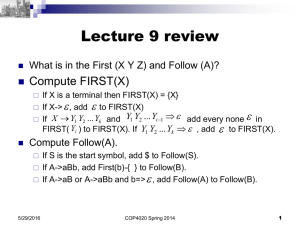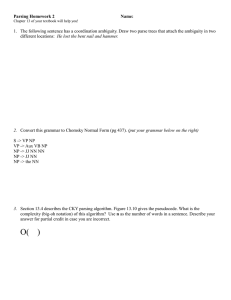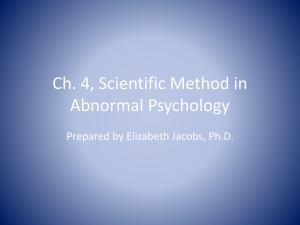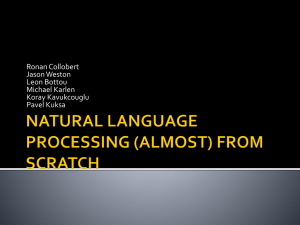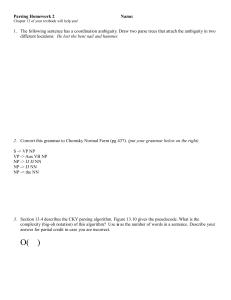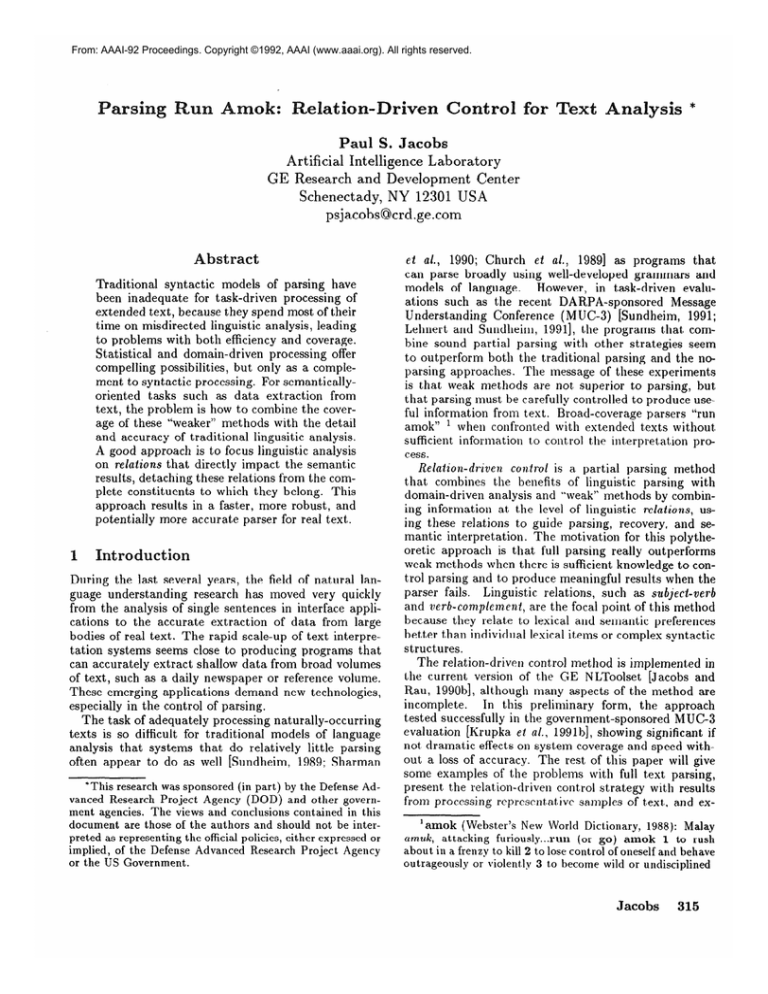
From: AAAI-92 Proceedings. Copyright ©1992, AAAI (www.aaai.org). All rights reserved.
atism- riven Control
Analysis *
Paul S. Jacobs
Artificial Intelligence Laboratory
GE Research and Development Center
Schenectady, NY 12301 USA
psjacob&crd.ge.com
Abstract
Traditional
syntactic
models of parsing have
been inadequate
for task-driven
processing of
extended text, because they spend most of their
time on misdirected linguistic analysis, leading
to problems with both efficiency and coverage.
Statistical
and domain-driven
processing offer
compelling possibilities,
but only as a complement to syntactic processing.
For semanticallyoriented tasks such as data extraction
from
text, the problem is how to combine the coverage of these “weaker” methods with the detail
and accuracy of traditional
lingusitic analysis.
A good approach is to focus linguistic analysis
on relations that directly impact the semantic
results, detaching these relations from the complete constituents
to which they belong. This
approach results in a faster, more robust, and
potentially
more accura.te parser for real text.
1
Introduction
During the last several years, the field of natural language understanding
research has moved very quickly
from the analysis of single sentences in interface applications to the accurate
extraction
of data from large
bodies of real text. The rapid scale-up of text interpretation systems seems close to producing programs that
can accurately extract shallow data from broad volumes
of text, such as a daily newspaper or reference volume.
These emerging applications
demand new technologies,
especially in the control of parsing.
The task of adequately processing naturally-occurring
texts is so difficult for traditional
models of langua.ge
analysis that systems that do relatively
little parsing
often appear to do as well [Sundheim,
1989; Sharman
*This research was sponsored (in part) by the Defense Advanced Research
Project
Agency (DOD) and other government agencies.
The views and conclusions
contained
in this
document
are those of the authors and should not be interpreted as representing
the official policies, either expressed or
implied, of the Defense Advanced
Research
Project
Agency
or the US Government.
et al., 1990; Church
et al., 19891 as programs
that
can parse broadly using well-developed
grammars
and
However, in task-driven
evalumodels of language.
ations such as the recent DARPA-sponsored
Message
Understanding
Conference
(MUC-3)
[Sundheim,
1991;
Lehnert and Sundheim,
19911, the programs that, combine sound partial parsing with other strategies
seem
to outperform
both the traditi0na.l parsing and the noparsing approaches.
The message of these experiments
is that weak methods are not, superior to parsing, but
that parsing must be carefully controlled to produce useful information
from t,est. Broad-coverage
parsers “run
amok” ’ when confronted with extended texts without
sufficient,
information
to control
t,lie interpretation
pro-
cess.
Relation-driven
that
combines
control
the
benefits
is a
of
partial
parsing
linguistic
method
parsing
with
domain-driven
analysis and “weak” methods by combining information
at the level of linguistic
relations, using these rela.tions t<o guide parsing, recovery, and semantic interpretation.
The motivation for this polytheoretic approach is that full parsing really outperforms
wea.k methods when there is sufficient knowledge to cont’rol parsing and to produce meaningful results when the
parser fails.
Linguistic
relations,
such as subject-verb
and verb-complement,
are the focal point of this method
because they rela.te to lexical and semantic preferences
better than individual lexical items or complex synta.ctic
structures.
The relation-driven
control method is implemented in
the current version of the GE NLToolset
[Jacobs and
Rau, 1990b], although many aspects of the method are
incomplete.
In this preliminary
form, the approach
tested successfully in the government-sponsored
MUC-3
evaluation [Krupka et nl., 1991b], showing significant if
not dramatic effects on system covera.ge and speed without a loss of accuracy.
The rest of this paper will give
some examples of tahe problems with full text parsing,
present the relat,ion-driven
control strategy with results
from processing representat~ive samples of text, and ex‘amok
(Webst,er’s
New World Dictionary,
1988):
Malay
umul;, attacking
furiously . . ..run (or go) amok
1 to rush
about in a frenzv to kill 2 to lose control of oneself and behave
outrageously
or’ violent)ly 3 to become wild or undisciplined
Jacobs
315
plain how the method
text extraction
system.
2
Problems
text
impacts
the performance
in extracting
of the
data from real
No data extraction
system can adequately
process an
arbitrary text in an arbitrary
domain.
The limitations
come both from failed parses and absurd interpretations
that serve no useful purpose.
The current state of the art is that programs can
perform very limited processing of fairly broad bodies
of text as in news categorization,
[Hayes et al., 1988;
Jacobs, 1992131, and somewhat more detailed processing
of similar texts in constrained domains [Sundheim, 19911.
It is within reason to expect that work over the next several years will produce programs that can, for example,
read a daily newspaper and extract useful, structured information from most items. The breadth and accuracy
of parser coverage is clearly still in the critical path, as
linguistic parsers tend to be of little help once the severe
constraints
of a domain are lifted.
As an example of the effects of these problems,
the
following is an analysis of a typical sentence selected from
a corpus of WaZZStreet Journal text (November 2, 1989)
obtained through the ACL Data Collection
Initiative,
along with some of the problems that our system had on
its first pass at analyzing this corpus [Jacobs et al., 19901.
We have informally verified that many other language
analysis programs have most of the same problems.
The first sentence of the WaZZStreet Journal story is
as follows:
A form of asbestos once used to
cigarette filters has caused a high
of cancer deaths among a group of
posed to it more than 30 years ago,
reported.
(34 words)
make Kent
percentage
workers exresearchers
This text is about typical in length and complexity
for the first sentence of a news story, and was not from
any domain that we had covered. While the system did
produce some valid semantic information,
such as that
asbestos had caused the dea.ths, that cancer is a disease,
and that the workers were somehow involved in dying, it
encountered
the following difficulties, which we consider
to be representative:
e Failed parses and attachments,
e.g., the phrase to
make Kent cigarette filters was attached as a prepositional phrase modifying form, because used does
not allow an infinitive complement.
o Extraneous
considerations,
e.g., the program found
several parses with the noun phrase Kent cigarette
filters broken up, with used as the main verb of the
sentence or with jilters as a verb.
a Inadequate
depth of interpretation,
e.g.
the program correctly
determined
that cancer modified
deaths, as well as the sense of among, but did not
produce any representation
of the fact that cancer
316
Natural
Language:
Parsing
somehow
died.
caused
t,he deaths
and tl1a.t t,he workers
Clearly, some of these problems result from a lack of
system knowledge; for example, the program did not recognize the word asbestos and should have been able to
link diseases to deaths (since it, did “know” that cancer
On the other hand, just as many of the
is a disease).
is, the
problems result from too much knowledge-that
extra work and false interpretations
stemming from the
complexity of the system. These problems boil down to
two paradigmatic
issues-coverage
and attachment.
The double-edged
sword
of coverage
Extending
a parsing system’s knowledge base avoids
“gaps” and increases the range of inputs that can be interpreted, but also increases the combinat#orics of parsing
and the likelihood that the system will produce an incorrect interpretation.
For example, knowing that make
and high can be nouns seems necessary
for handling
real texts, but the system must’ discard such possibilities quickly from consideration
in the Iient cigarette
example.
Similarly,
determiners
are optional in many
prepositional
phrases wit,11 the preposition
to, but this
knowledge can cause spurious parses of many infinitive
phrases.
Intuitively,
disambiguating
to at the sentence
level doesn’t seem to make sense, if to lunch is a thousa.nd times more likely to be a prepositional
phrase tl1a.n
to n?crke. But this is precisely the sort of disa.mbiguation
most pa.rsers t,ry t#o do, often relying on sentence-level
constraints where “weaker” lexical or domain knowledge
would produce much bet,ter result,s.
The entrapment
of at tacluneut
Attachment,
especially of prepositional
phrases, has
been the focus of much parsing work (e.g. [Frazier and
Fodor, 1978; Schubert,
19861) because it is the source of
most, of the combinatorics
in parsing. Yet phrase a.ttachment, does not, a.lways contribute very much to t,he results
of text analysis, particularly
in dat#a. extraction.
Even
worse, an otherwise inconsequential
a.ttachment decision
can actually interfere with get)tiiig t,lie correct semantic
interpretation.
Regardless of the degree to which syntax contributes
to correct attachment,,
t,he combination
of at,tachment
possibilities
is a misdirected
parsing effort. In addit,ion
to phrases like nllzo~~,gn group of workers, which can legitimately att#a.ch in three places, t#emporal modifiers like
more than 30 years ago ca.n attach almost anywhere.
This sort of phrase is especially common in uews stories.
The result is that, a typical parser spends more
time deliberat*ing where to at*tach phrases whose attachment doesn’t help sema.nt,ic interpretation
than it does
on phrases whose attachment,
does mat.ter, and parsing
is fuiidament~ally misdirected.
The relation-driven
control strategy,
by loosely coupling linguistic processing and attachment
to constituent
structure,
a.voids problems wit 11 spurious lexical and at-
tachment decisions
from a combination
3
and allows these decisions
of knowledge sources.
Relation-driven
to derive
control
At the heart of these issues is the problem that most
full parsers are fundamentally
clause-driven,
from the
extreme case of those that produce no information
at
all when they fail to recognize a sentence, to the more
typical parsers that resolve attachment
ambiguities
at
the sentence level. Many programs often can’t tell if a
word is a noun or a verb without building a complete
sentence structure around it.
Relation-driven
control is a model of parsing and semantic interpretation
in which linguistic relations serve
as the focal point of analysis.
These relations, such as
those between subject and verb, verb and complement,
or noun and modifier, are independent of syntactic analysis in that they are not tied to a particular complex linguistic structure.
While the relations are themselves linguistic structures,
they associate easily with conceptual
roles and statistical
knowledge (such as co-ocurrence),
making it easier to validate them without a full parse.
Figure 1 breaks down the major components
of our
system,
showing how relation-driven
control mediates
among three general types of processing-(
1) corpusdriven,
shallow pre-processing,
(2) linguistic
analysis, including parsing and semantic interpretation,
and
mainly template-filling
and other
(3) post-processing,
domain-driven
processing.
The term template here refers
to the final result of data extraction-a
frame with a
set of conceptual
features for each particular
type of
object or event (see Section 4). This model is implemented, although there is a great deal more work to be
done, particularly
in expanding the pre-processing
and
recovery components.
The system uses the TRUMP [Jacobs, 1992c] analyzer, and is currently being extended
to use Carnegie Mellon University’s
implementation
of
Tomita’s algorithm [Tomita, 19861 for multi-lingual
processing under the government-sponsored
TIPSTER
program.
A relation is a triple consisting of a head, a role, and
a filler (or non-head).
Each linguistic relation ma.ps into
a conceptual
relation that associates word senses with
conceptual
roles, giving rise to three types of semantic
preferences.
Figure 2 illustrates a relation and the three
types of preferences.
Relations can derive from lexical preferences and other
patterns established
during pre-processing,
from the semantic interpretation
of constituents
during parsing, and
from domain knowledge
when recovering
from failed
parses.
Relation-driven
control focuses the interpretation task on determining
a preference
score for each
sense of each content word in the text, along with the
semantic and template roles associated with that word
sense. During interpretation,
the program drops linguistic structures
with low relation scores.
After syntactic
processing, the matrix of preference scores produces a total that selects the preferred interpretation
of the text,
even where the system has failecl to produce a complete
parse.
The role preference shown in Figure 2 is a measure of
how well the filler fills a role. This is where the equivalent
of selectional restrictions,
and most domain knowledge,
comes into play. For example, foods make good fillers
for the patient of eating activities.
Such preferences can
be expressed even at the level of individual senses; for
example, pibot is a good filler for the agent role of flying
activities.
The rel preference measures the salience of a role with
respect to the head. For example, concepts such as monetary objects and units of measure “expect” to be qualified by some quantity. Thus, while the baseline preference for yard is for an enclosed area, the preferred interpretation of ten yards is as a measure. There is no reason
why areas shouldn’t be modified by quantities,
but the
role is much more salient for measures.
The base preference associates the filler with the head,
independent of the particular role. For example, employment actions and professions tend to be related, regardless of roles. Thus art employmcni would typically mean
the hiring of people in the art, profession,
rather than
the use of works of art (or any of the other poor sense
combinations).
Distinguishing
this sort of preference is
necessary because the language very often provides little
information
about the conceptual role.
In the example shown in Figure 2, the sentence incomcludes a free infinitive adjunct to be acquired...-a
mon sort of interpretation
problem because the normal
syntactic preferences would be to try to attach the phrase
starting
with the rightmost, “node” (agreement).
The
role target is salient, and a company makes a good filler
for the role, so both role and reI preferences are very high
in the relation shown. The system thus favors any parse
tl1a.t will include t,his relation, and will attempt to retain
the relation even if the parser fails.
The rela.tion-driven cont5rol triangle supports fault tolerance, because strong preferences coming from any part
of t’his dat’a struct’ure can determine the remaining portions. For example, a strong base preference often guides
a.ttachment decisions even in t,he a.bsence of role preferences.
Most weights in the system are assigned automatically,
either through statistical
analysis in the case of collocat,ions or by a knowledge-based
rule that computes preference scores according to their position in the hierarchy. Thus a preference for food is automatically
assigned
a higher weight than a preference for animafe because
food is deeper in the hierarchy (i.e.
the weight is assigned a.utomatically;
the preference
itself is manually
coded). This method is reasonably effective because the
interpreter
is most oft.en comparing one or two combinations with preferences to a great many combinations
with no preferences or nega.tive preferences (violated restrictions).
The discussion that, follows gives some more details
and examples of the benefits of relation-driven
control
with respect t,o the corpus- and t,a.sk-driven components
Jacobs
317
Pre-processing
IAnalysis
Figure
1: Sta.ges of data extraction
of the system.
3.1
Pre-processing
Pre-processing
helps to segment texts, control the interpretation
of words in the text, and identify where
phrase attachment
is necessary.
As Figure 1 shows, the
relation-driven
control strategy depends on key information that the system obtains prior to parsing, including
lexical preferences and other “dynamic” lexical information, statistical
results such as phrase acquisition
[Jacobs, 1992a], and template activation and other domainspecific segmentation.
2
The following is a sample text taken from the development corpus of the MUC-3 message understanding
evaluation, with the results of the segmentation
component
of pre-processing:
Original
text:
SIX PEOPLE
WERE KILLED AND FIVE
WOUNDED
TODAY
IN A BOMB
ATTACK
THAT
DESTROYED
A PEASANT
HOME
IN THE
TOWN
OF QUINCHIA,
ABOUT
300 KM WEST
OF BOGOTA,
IN
THE
COFFEE-GROWING
DEPARTMENT
OF RISARALDA,
QUINCHIA
MAYOR SAUL
BOTERO
HAS REPORTED.
(41 words)
Segmented
text:
[SIX PEOPLE]
[WERE KILLED]
AND FIVE
[WOUNDED]
[TIME: TODAY]
[IN A BOMB
ATTACK]
THAT
[DESTROYED]
[A PEASANT HOME] [LOCATION:
IN THE TOWN
2The identification
of segments of texts that
fill templates
is described in [Jacobs,
19901
318
Natural
Language:
Parsing
activate
and
OF
QUINCHIA]
[DISTANCE:
*COMMA*
ABOUT
300 KM WEST
OF BOGOTA]
[LOCATION: *COMMA*
IN THE COFFEE
*HYPHEN* GROWING
DEPARTMENT
OF RISARALDA] [SOURCE:
*COMMA*
QUINCHIA
MAYOR SAUL BOTERO
HAS REPORTED]
*PERIOD*
The task in processing these examples is to fill, for each
news story, a set of possible templates,
each cont,aining
18 fields indicating t.he t,ype of event, perpetrator(s),
victim(s), etc.
By grouping and labeling portions of text early, the
program greatly reduces the amount of real parsing that
must be done, eliminates
many failed parses, and provides template-filling
information
that helps with later
processing.
For example,
the phrase in ihe town of
Quinchia is at least five ways ambiguous-it
could modify a peasant h.ome, destroyed, a bomb attack, wounded,
or were killed and jive [were] wounded. However, all five
of these possibilities
have the same effect on the final
templates produced, so the program can defer any decisions about how to parse these phrases until after it has
determined
that the killing, wounding, at#tacking, and
destruction
are all part’ of the same event. Since these
choices combine with the anlbiguity of other phrases, the
parsing process would otherwise be needlessly combinatoric. In fact, parsing cont8ributes nothing after a peasant
home, so this sentence can be processed as a l&word example with some extra modifiers.
In addition to reducing the combinatorics
of modifier attachment,
this pre-processing
helps in resolving
false ambiguities that are a matter of style in this sort of
text. In this example, the ellipsis in five [were] ,wounded
would be difficult, except that, wounded, like many transitive verbs, is never used as an active verb wit,hout a di-
role preference:
rel preference;
How much does “acquire”
want a TARGET?
How well does “Burndy Corp. ”
fit the TARGETrole?
is there a lexical relation
between “‘Burndy” and
“acquired”?
Norwalk, Conn. -DJ-
We
Figure
2: Relations
rect object.
The early bracketing of the text allows the
parser, through the relation-driven
control module, to
resolve the common past participle-past
tense ambiguities without having to wait for a complete verb phrase.
3.2
Domain-driven
processing
The integration of domain-driven
analysis and linguistic
analysis is probably the hardest and most critical problem for data extraction
systems,
as explained in [Rau
and Jacobs,
19883 and [Passonneau
et al., 19901. With
relation-driven
control, the system looks for linguistic relations in the text that affect template filling whether or
not it succeeds in producing a complete parse, and avoids
relations that do not influence template filling. The segmentation of the text during pre-processing
guides this
process. Relation-driven
control uses the template activators, typically verbs, as “pivots”, and looks for relations (such as subject-verb
and verb-object)
that might
include each pivot. These attachments
do not wait for
a complete parse, so this method is more robust, and
favors attachments
that are valid in the domain.
Relation-driven
control depends on having a rough
structure of the events of the text prior to parsing. This
is realistic in most domains we have dealt with, including
the terrorism stories, where death and destruction
are
subsidiary to attacks and bombings.
3 The event structure determines what roles must be filled linguistically,
avoiding attachment
of shared roles (such as instrument,
time and location) and favoring the attachment
of valid
roles.
In this example, the program produces the templat,es
in Figure 3.
31n corporate
199Oa],
takeover
rumors,
events.
mergers
offers,
and acquisitions
[Jacobs and Rau,
and stock
moves
are subsidiary
and semant8ic preferences
This section has addressed the principal
cusing parsing to resolve the coverage and
problems described in Section 2. The next
present some preliminary
result,s from this
effort,.
4
System
evaluation
issues in foat,tachment
section will
broad-scale
and status
In earlier project’s, such as SCISOR
[.Ja.cobs and Rau,
199Oa] and other efforts involving the GE NLToolset
[Jacobs and Rau, 199Ob], our programs produced accuracy of over 80% in data extract,ion from texts in limited domains (for example, get,ting an average of 80%
of the suitors correct in stories about mergers and acquisitions)
and have compared very favora.bly to other
systems in evaluat,ions on a. common task. The system
was in t,he t’op group in every measure in t,he MUC3 evaluation [Krupka ef nl., 1991a; Lehnert and Sundheim, 19911 ( w 111~
’ 11 uses a much harsher scoring method),
while producing half a.s many templates as most of the
otther top systems. The program increased in processing
speed over a two-year interval by a fa.ctor of 12, to over
1000 words/minute.
Most importantly,
the techniques
described here helped achieve accuracy in MUC-3 comparable to the MUCK-II
evaluation
two years earlier,
although an analysis showed MUC-3 at least an order
of magnitude
broader [Hirschman,
19911 along several
dimensions.
Having been t,ested in an early version in MUC-3, the
relation-driven
cont.rol stra.tegy is a major component of
the GE-CMU
team’s technical strategy in the DARPA
TIPSTER-Dat’a
Extraction
project.
Interestingly,
this
strategy is the closest to traditional
parsing of all the
TIPSTER
teams, with other groups relying more heavily on met~hods such as probabilistic
parsing and phrasebased domain-driven
analysis.
One of the major moti-
Jacobs
319
ID
P* MESSAGE
TEMPLATE ID
DATE OF INCIDENT
l
3: TYPE OF INCIDENT
CATEGORY OF INCIDENT
:*. PERPETRATOR:ID OF INDIV(S)
PERPETRATOR:ID OF ORG(S)
i: PERPETRATOR:CONFIDENCE
PHYSICAL TARGET: ID(S)
9: PHYSICAL TARGET: TOTAL NUM
10. PHYSICAL TARGET: TYPE(S)
11. HUMAN TARGET: ID(S)
12. HUMAN TARGET: TOTAL NUM
13. HUMAN TARGET: TYPE(S)
' 14. TARGET: FOREIGN NATION(S)
15. INSTRUMENT:TYPE(S)
16. LOCATION OF INCIDENT
17. EFFECT ON PHYSICAL TARGET(S)
18. EFFECT ON HUMAN TARGET(S)
1)EV-MUC3-0644
67 NOV 89
BOMBING
TERRORISM
:PEASANTHOME"
ATHER
"PEOPLE"
%ILIAN
ZOLDMBIA:QUINCHIA (CITY):
RISARALDA (DEPARTMENT)
SOME DAMAGE
DEATH
INJURY
EEV-MUC3-0644(GE)
87 NOV 89
MURDER
TERRORISM
HUMAN TARGET: ID(S) - .
HUMAN TARGET: TOTAL NUM
HUMAN TARGET: TYPE(S)
TARGET: FOREIGN NA'iIilNW
INSTRUMENT:TYPE(S)
16. LOCATION OF INCIDENT
17. EFFECT ON PHYSICAL TARGET(S)
18. EFFECT ON HUMAN TARGET(S)
*
*
"PEOPLE"
&vILIAN
BOMB
COLOMBIA:QUINCHIA (CITY):
RISARALDA (DEPARTMENT)
*
*
Figure
3: Results
vations for the emphasis on control strategy in the GECMU team has been to take advantage of the established
framework of the CMU Generalized LR Parser within the
context of GE’s text processing system. This project is
barely underway; however, the system has already processed its first message set after the integration
of the
CMU parser with a GE grammar and pre-processor.
The
combination of systems of this scope in linguistic analysis
is, to our knowledge, unprecedented,
and illustrates the
growing importance
of control strategies for combining
different analysis technologies.
5
Conclusion
The relation-driven
control strategy
directs linguistic
processing toward identifying and disambiguating
relations centering on relevant portions of text, instead of on
completing
and attaching
syntactic
constituents.
This
strategy eliminates
much of the needless combinatorics
of parsing without ignoring the syntactic constraints and
preferences
that affect semantic results.
This ongoing
work has produced an efficient parser with broad coverage that has been applied to large quantities of real text,
with some promising results in word sense discrimination
and data extraction.
320
Natural
Language:
Parsing
of Data. Extraction
References
[Church et al., 19891 I<. Church, W. Gale, P. Hanks, and
D. Hindle. Parsing, word associations,
and predicatea.rgument relations.
Iii Proceedings
of ihe Iiltern.ational Workshop 011 Parsing
Technologies.
Carnegie
Mellon University, 1989.
[Frazier and Fodor, 19781 L. Frazier and J . D. Fodor.
The sausage machine: A new two-stage parsing model.
Cognition., 6:291-325,
1978.
[Hayes et al., 19883 Phil
Hayes,
Laura
Knecht,
and
Monica Cellio.
A news story ca.tlegorization system.
In Proceedings of Second Conference
on Applied Natural Language Processing, Austin, TX, February 1988.
Associa$ion for Comput8a.tional Linguistics.
Hirschman,
199 l] L. Hirschman.
Comparing
muck-ii
and muc-3: Notes on evaluating the difficulty of different tasks. In Proceedings of fhe Third Message Understanding Colzference (MrJC-.9), San Ma.teo, <‘A, May
1991. Morgan I<aufma.nn Publishers.
Jacobs and Rau, 199Oa] Paul Jacobs
and Lisa Rau.
SCISOR:
Extracting
information
from on-line news.
C~onlllzllnicntiolzs of th,e Associniion
for c‘on7puting
Machinery,
33( 11):88-97,
November 1990.
[Jacobs and Rau, 1990b] Paul S. Jacobs
and Lisa F.
A software foundation
Rau . The GE NLToolset:
In Proceedings
of
for intelligent
text processing.
the Thirteenth International
Conference
on ComputaHelsinki,
tional Linguistics, volume 3, pages 373-377,
Finland, 1990.
[Jacobs et al., 19901 Paul S. Jacobs, George R. Krupka,
Susan W. McRoy, Lisa F. Rau, Norman K. Sondheimer, and Uri Zernik.
Generic text processing:
A
progress report. In Proceedings of the Third DA RPA
Speech and Natural Language
Workshop,
Somerset,
PA, June 1990. Morgan Kaufmann.
[Jacobs, 19901 Paul Jacobs.
To parse or not to parse:
Relation-driven
text skimming.
In Proceedings
of
the Thirteenth International
Conference
on Gomputational Linguistics,
pages 194-198,
Helsinki, Finland,
1990.
[Jacobs, 1992a] Paul S. J acobs. Acquiring phrases statistically.
In Proceedings
of the 30th Annual Meeting of the Association for Computational
Linguistics,
Newark, Delaware, 1992. Submitted.
[Schubert,
19861 L. Schubert.
Are there preference
In Proceedings
trade-offs in attachment
decisions?
of the Fifth National Conference
On Artificial Intelligence, 1986.
[Sharman et al., 19901 R. Sharman,
F. Jellinek,
and
R. Mercer. Generating a grammar for statistical training. In Darpa Speech and Nafural Language Workshop,
Hidden Valley, Pa, 1990.
[Sundheim, 19891 Beth Sundheim.
Second message understanding
(MUCK-II)
report.
Technical
Report
1328, Naval Ocean Systems Center, San Diego, Ca,
1989.
[Sundheim,
19911 Beth Sundheim, editor. Proceedings of
the Third Message Understanding
Conference
(Muc3). Morgan Kaufmann
Publishers,
San Mateo, Ca,
May 1991.
Eficient
Parsing
[Tomita, 19861 M. T omita.
ral Language. Kluwer Academic Publishers,
Massachusetts,
1986.
for NatuHingham,
[Jacobs, 1992b] Paul S. Jacobs.
Joining statistics
with
NLP for text categorization.
In Proceedings of the 3rd
Conference
on Applied Natural Language Processing,
April 1992.
[Jacobs, 1992c] Paul S. Jacobs.
TRUMP:
A transportable language understanding
program.
International Journal
of Intelligent
Systems, 7(3):245-276,
1992.
[Krupka et al., 1991a]
George R. Krupka, Lucja Iwariska, Paul S. Jacobs,
and Lisa F. Rau. GE NLToolset:
Muc-3 test results
and analysis. In Proceedings of the Third Message Understanding
Conference
(Muc-3), San Mateo, Ca, May
1991. Morgan Kaufmann
Publishers.
Paul S. Ja[Krupka et al., 1991b] George R. Krupka,
cobs, Lisa F. Rau, and Lucja Iwaliska.
Description
of the GE NLToolset system as used for Muc-3.
In
Proceedings of the Third Message Understanding
Conference (Muc-31, San Mateo, Ca, May 1991. Morgan
Kaufmann Publishers.
[Lehnert and Sundheim,
19911 Wendy G. Lehnert and
Beth M. Sundheim.
A performance
evaluation of text
analysis technologies.
Artificial In.telligence Magazine,
12(3):81-94,
Fall 1991.
Passonneau,
[Passonneau
et al., 19901 R.
C. Weir, T. Finin, and M. Palmer. Integrating natural
language processing and knowledge based processing.
In Proceedings
of the Eighth National Conference
on
Artificial Intelligence,
pages 976-983,
Boston, 1990.
[Rau and Jacobs,
19SS] Lisa F. Rau and Paul S. Jacobs. Integrating
top-down and bottom-up
strategies
in a text processing system. In Proceedings of Second
Conference
on Applied Natural Language Processing,
pages 129-135, Austin, TX, Feb 1988. ACL.
Jacobs
321

